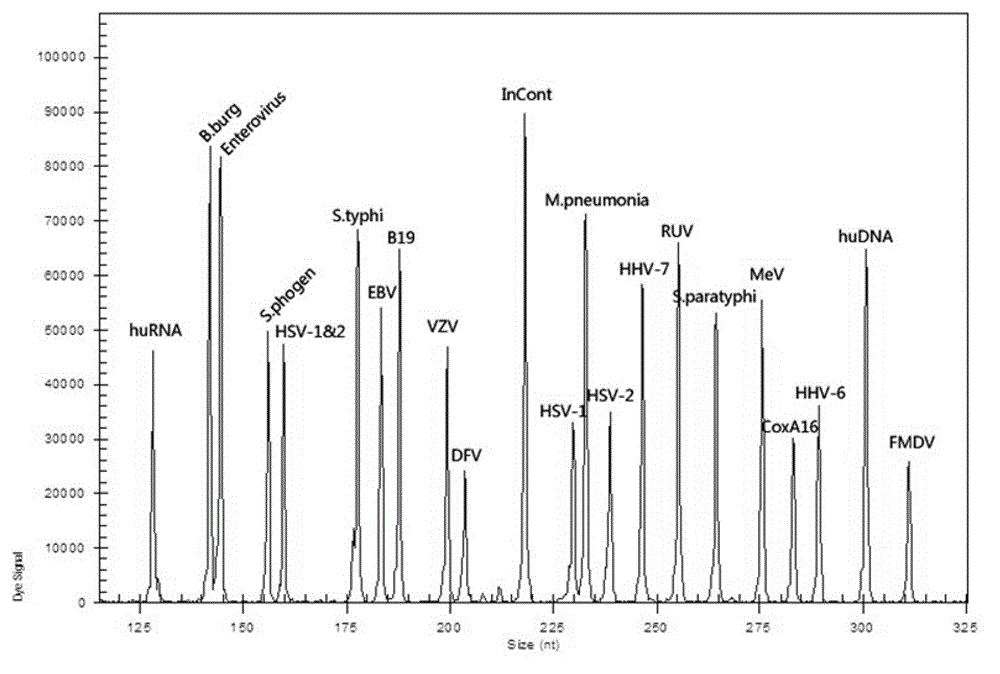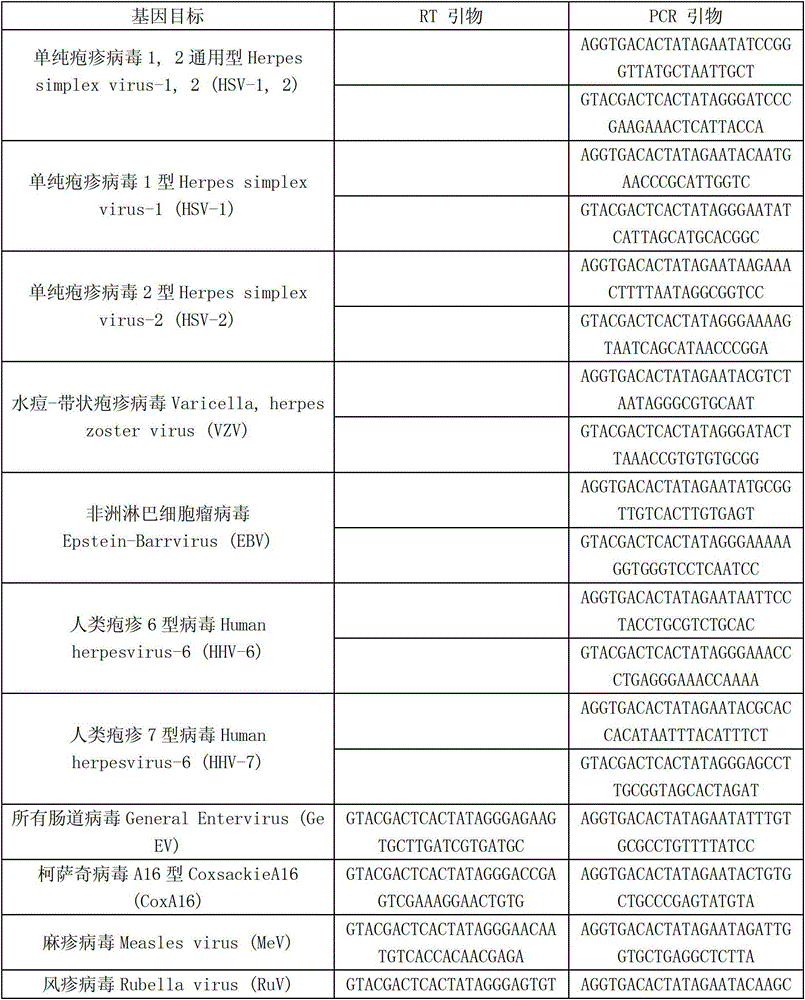Kit capable of synchronously detecting eighteen kinds of fever with eruption pathogens and detection method thereof
A technology for simultaneous detection of pathogens, applied in the direction of microbial-based methods, biochemical equipment and methods, microbial measurement/testing, etc., can solve the problems of time-consuming and labor-consuming antibodies, expensive technical costs, and increased costs, and achieve good sensitivity and specificity, avoid low specificity, and save production costs
- Summary
- Abstract
- Description
- Claims
- Application Information
AI Technical Summary
Problems solved by technology
Method used
Image
Examples
specific Embodiment 1
[0035] The present invention is a kit for synchronous detection of eighteen kinds of pathogens with fever and rash, including DEPC water, 5×RT buffer, reverse transcription primer (RT primer mix), RT enzyme (full name reverse transcriptase), X solution , 10×PCR buffer, PCR primers, 25mM magnesium chloride solution, DNA polymerase, and the positive control substance is obtained by cloning each target pathogen, including the target fragment plasmid. 5×RT buffer, 10×PCR buffer, 25mM magnesium chloride solution, and DNA polymerase were ordered from Sigma Company. The reverse transcription primers include the RT amplification primers of the five fever and rash pathogens in Table 1 and the RT amplification primers of the human RNA internal reference. The above PCR primers include the positive and negative of the remaining thirteen fever and rash pathogens in Table 1. PCR amplification primers, forward and reverse PCR amplification primers of herpes simplex virus 1,2 universal type, ...
specific Embodiment 2
[0064] The present invention is a method for synchronously detecting eighteen kinds of pathogens with fever and rash. The detected pathogens with fever and rash include herpes simplex virus 1, herpes simplex virus type 2, varicella-zoster virus, African lymphoma virus, Human herpes 6 virus, human herpes 7 virus, enterovirus and its subtype (Coxsackievirus A16), measles virus, rubella virus, parvovirus B19, foot-and-mouth disease virus, Streptococcus pyogenes, Mycoplasma pneumoniae, dengue virus , typhoid, paratyphoid Salmonella, Borrelia burgdorferi, etc. (see Table 1), collect patient samples (nasopharyngeal swab, sputum, herpes fluid, blood, etc.), extract nucleic acid, and use patient nucleic acid as a template for reverse transcription React with PCR, and finally separate the sample by capillary electrophoresis, the specific steps are as follows:
[0065] 1. Production of kits for simultaneous detection of eighteen kinds of pathogens with fever and rash based on the GeXP m...
specific Embodiment 3
[0093] Detection Kit Sensitivity and Specificity Analysis
[0094] Sensitivity analysis: After diluting the positive control according to a certain copy number ratio, it is detected by PCR amplification and capillary electrophoresis until no signal is detected. The copy number is the lowest detection line, which is the sensitivity of the kit. The detection sensitivity is up to 40 copies / uL.
[0095] Specificity analysis: Single-plex PCR amplification is detected as a single peak of the target fragment size by capillary electrophoresis.
PUM
 Login to View More
Login to View More Abstract
Description
Claims
Application Information
 Login to View More
Login to View More - R&D
- Intellectual Property
- Life Sciences
- Materials
- Tech Scout
- Unparalleled Data Quality
- Higher Quality Content
- 60% Fewer Hallucinations
Browse by: Latest US Patents, China's latest patents, Technical Efficacy Thesaurus, Application Domain, Technology Topic, Popular Technical Reports.
© 2025 PatSnap. All rights reserved.Legal|Privacy policy|Modern Slavery Act Transparency Statement|Sitemap|About US| Contact US: help@patsnap.com



